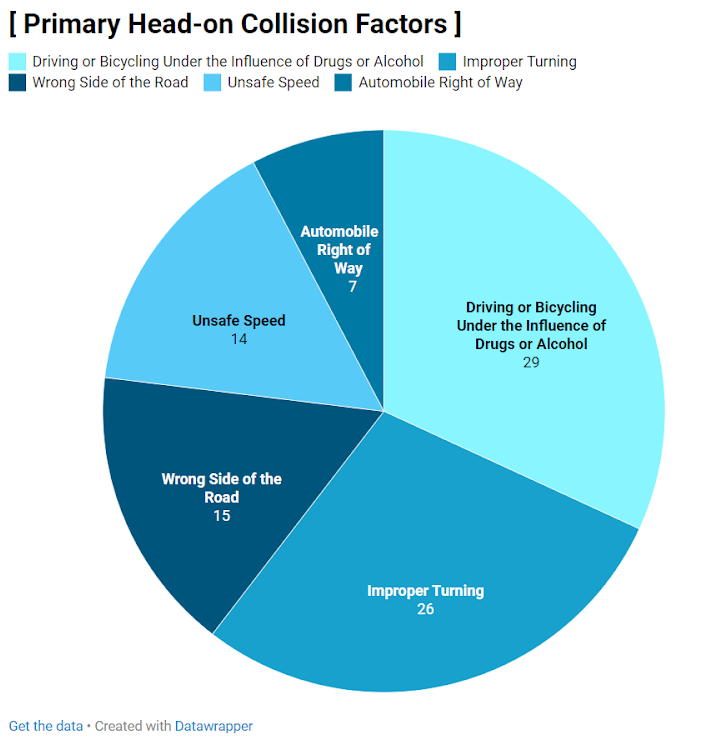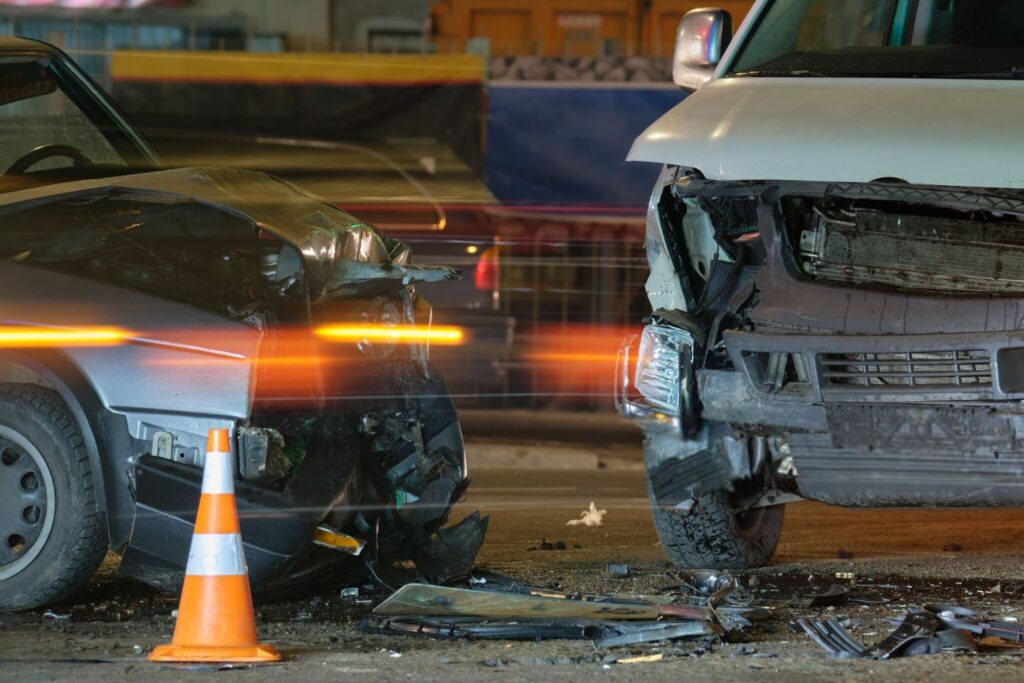Head-on collisions are among the most serious car accidents, and California’s roads have seen too many. From 2008 to 2017, these crashes led to over 8,500 deaths and more than 26,000 serious injuries. These statistics emphasize the importance of awareness for victims.
If you have been injured due to a head-on collision in California, remember that you are not alone. This blog post covers everything you need to know following such a crash, from immediate steps to relevant legal resources.
Read on to seek practical guidance and get the compensation you truly deserve.
Leading Causes of Head-On Collisions in California
Head-on collisions in California stem from a variety of violations. Statewide statistics from the California Collison Overview Fact Sheet provide a clear picture of the primary factors contributing to these serious incidents.


- Driving Under the Influence (DUI): A staggering 29% of head-on collisions are due to DUI. This includes drivers impaired by alcohol exceeding the legal limit, or those under the influence of drugs. Driving under the influence leads to loss of vehicle control and judgment errors.
- Improper Turning: Making up 26% of collisions, improper turning poses a serious hazard. Such accidents are caused by making illegal left turns at intersections, ignoring ‘No U-Turn’ signs, or misjudging oncoming traffic.
- Wrong Side of the Road: This cause accounts for 15% of incidents. Examples include drivers entering a one-way street in the wrong direction, overtaking on a blind curve, or drifting across a median into oncoming lanes.
- Unsafe Speed: Speeding is behind 14% of head-on crashes. Speeding includes driving significantly over the speed limit, or too fast for certain road conditions like sharp bends, where the driver may lose control and swerve into opposite lanes.
- Automobile Right of Way: Violations regarding the right of way contribute to 7% of collisions. These incidents often occur when a driver fails to observe stop signs, yield signs, or traffic lights. Such actions force other drivers into taking defensive maneuvers that can result in a head-on collision.
After a head-on collision, the road to recovery can seem distressing. Let the Personal Injury Center offer you the support you need during these difficult times. We will connect you with dedicated personal injury attorneys in your region who will help you secure the settlement you deserve.
Legal Codes Related to Head-on Collisions in California
When a head-on collision occurs, it is essential to know the legal steps and your rights. Here’s an overview of key legal codes that you need to be aware of if you’re involved in a head-on collision in California.


Reporting the Accident
Under Vehicle Code 20008, anyone involved in a car accident that results in injury or death must report the incident to the California Highway Patrol or local police within 24 hours. This legal obligation ensures that there’s an official record of the event, which is critical when pursuing legal claims.
Seeking Damages for Injuries
California’s Civil Code 1431.2, known as the ‘Pure Comparative Fault Rule,’ allows victims to recover damages even if they are partly at fault. The compensation is adjusted based on the percentage of fault. This means if you’re found to be 30% responsible for the accident, your damages will be reduced by that amount.
The Statute of Limitations
California Code of Civil Procedure 335.1 sets a two-year limit on the time you have to file a lawsuit for personal injury and a three-year limit for property damage. If you miss these deadlines, you’re typically barred from bringing a claim to recover damages.
Financial Responsibility
California Vehicle Code 16000 requires all drivers to file an SR-1 form with the DMV in the event of an accident that involves injuries, deaths, or property damage exceeding $1,000. This form is part of proving you have the minimum insurance coverage required by law.
Safe Driving Obligations
The California Basic Speed Law, covered by Vehicle Code 22350, implies that you must never drive faster than is safe for current conditions. For head-on collisions, if excessive speed or reckless driving is involved, this law becomes particularly pertinent in establishing negligence.
Securing Your Financial Recovery
California’s Vehicle Code 16020 requires all drivers to carry evidence of financial responsibility, such as an insurance policy. This is crucial in head-on collisions, as victims will need to claim against the at-fault driver’s insurance. Failing to provide proof of insurance at the scene can result in penalties for the responsible party.
Uninsured and Underinsured Motorist Protection
In cases where the at-fault driver lacks adequate insurance, victims can turn to their own policy. According to California Insurance Code 11580.2, policies must offer uninsured motorist (UM) and underinsured motorist (UIM) coverage. This law is a safeguard that allows victims to seek compensation through their own insurer if the other driver is uninsured or their coverage is insufficient.
Navigating legal complexities after a head-on collision can be overwhelming. Reach out to the Personal Injury Center today. We’ll link you with top personal injury lawyers in California who can help you fight for the compensation you’re entitled to.
Who Is at Fault in a Head-on Collision?


Determining who’s at fault in a head-on collision in California relies on clear-cut laws and the details of the accident. California’s vehicle codes lay down the rules that help figure out who is responsible. Here’s how these laws apply.
- Driving on the Wrong Side of the Road: California Vehicle Code 21651(b) makes it unlawful to drive on the wrong side of the road. If a driver is on the wrong side of a divided highway or street and a head-on collision occurs, they are typically deemed at fault.
- Driving Under the Influence (DUI): As per California Vehicle Code 23152(a), it is illegal to drive under the influence of alcohol or drugs. If a driver involved in a head-on collision is found to be under the influence, this significantly contributes to determining fault.
- Reckless Driving: California Vehicle Code 23103 defines reckless driving as driving with “willful or wanton disregard for the safety of persons or property.” A driver behaving recklessly and causing a head-on collision is likely to be found at fault.
- Distracted Driving: California Vehicle Code 23123.5 prohibits all drivers from using handheld wireless phones or electronic wireless communications devices while driving. If a head-on collision is due to a driver being distracted by such devices, they can be held liable.
- Failure to Yield: California Vehicle Code 21804(a) states that drivers must yield the right-of-way to oncoming vehicles when entering a roadway. Failure to do so can result in a head-on collision, placing fault on the driver who did not yield.
- Improper Passing: California Vehicle Code 21751 makes it unlawful to overtake and pass other vehicles on two-lane roads in an unsafe manner. If a head-on collision occurs during an improper passing maneuver, the passing driver is typically at fault.
- Roadway Hazards and Government Claims: Sometimes, head-on collisions are the result of poor road conditions rather than driver error. Under the California Government Code 835, a claim can be made against a public entity if an accident is caused by hazardous conditions on public property. Victims have a six-month period from the date of the incident to file a claim.
Common Mistakes to Avoid in Your Claim
Navigating a personal injury claim after a head-on collision can be complex. Avoiding these common errors can help safeguard your rights and maximize your potential compensation.
- Not Documenting Everything: Failing to keep detailed records can weaken your claim. Document everything from the scene of the accident, and medical reports, to dealings with insurance companies. Photos, police reports, and witness statements are critical pieces of evidence.
- Delaying Medical Treatment: If you wait too long to seek medical attention, the opposing party may argue that your injuries were not serious or were not related to the accident. Immediate medical evaluation creates an official record of your injuries.
- Underestimating Your Injuries: Don’t downplay your injuries. Some symptoms may appear or worsen days after the accident. It’s crucial to communicate all your symptoms to your healthcare provider and follow their treatment plan.
- Neglecting the Impact on Quality of Life: Beyond medical bills, consider how the injuries have affected your daily life. Claims can include pain and suffering, loss of enjoyment, and emotional distress.
- Accepting the First Settlement Offer: Often, initial offers are lower than what you may be entitled to. Accepting without consulting a legal expert might result in inadequate compensation for your losses.
- Posting on Social Media: Sharing details about your accident or recovery online can be detrimental to your case. Insurance companies may use your posts to downplay the severity of your injuries.
- Overlooking Future Costs: Some injuries require long-term care or rehabilitation. It’s important to consider future medical expenses, lost earning capacity, and other long-term effects when making a claim.
- Forgetting Expert Testimonies and Witnesses: Expert testimonies can have a significant impact on personal injury claims. They can provide credible insights into the cause of the accident as well as the extent of your injuries. Not including such testimonies may result in a less convincing claim.
- Failing to Consider All Responsible Parties: In some head-on collisions, the fault may not rest with one driver alone. Victims often overlook other potential defendants, such as vehicle manufacturers for defects, or government entities for unsafe road conditions. This can limit the sources from which damages can be recovered.
If you’re facing the aftermath of a head-on collision, contact the Personal Injury Center. Our team connects you with skilled personal injury lawyers who know the ins and outs of California’s legal landscape. Let us guide you toward the support and justice you deserve.
Key Takeaways
|
FAQs
What is a head-on collision with an example?
A head-on collision occurs when the fronts of two vehicles crash into each other. For example, if a car crosses over the centerline on a two-lane road and collides with an oncoming vehicle, that’s a head-on collision.
Who Is at fault in a head-on collision in California?
The fault is determined by evidence and relevant laws. Typically, the driver who veered into oncoming traffic, violating traffic laws such as California Vehicle Code 21651(b) (driving on the wrong side of the road), is at fault.
Why are head-on collisions so dangerous?
Head-on collisions are particularly dangerous due to the increased force of impact when two vehicles moving towards each other collide. This often results in more severe injuries and a higher likelihood of fatalities compared to other types of crashes.
What are the chances of surviving a head-on Collision?
Survival chances vary based on factors like speed at impact, safety features of the vehicles, and whether occupants are wearing seat belts. Generally, survival chances decrease as speeds increase and are lower in head-on collisions than in other types of accidents.
What are common injuries caused due to head-on collisions?
Common injuries from head-on collisions include fractures, traumatic brain injuries (TBIs), spinal cord injuries, internal organ damage, and lacerations.



